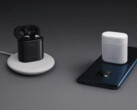We’ve been putting the Samsung Galaxy S10+ camera through its paces over the Australian Formula 1 Grand Prix weekend in Melbourne, Australia. We’ve found that it delivers a great overall camera experience producing still photos that are certainly in the same general ballpark as the iPhone Xs and the Pixel 3. The photos the Galaxy S10+ takes are detailed and vibrant, thanks to an imaging process that combines machine learning and camera hardware to deliver flagship-level photo performance.
However, one area where it clearly lags the iPhone Xs (and probably even the iPhone X) is with its front facing selfie/groufie cameras, particularly in low light situations. This was most apparent in the groufie (left) embedded below taken in a bar during the evening. It was a particularly testing situation, as chance would have it, with not only low light, but a combination of different lighting colors in the background. Complicating matters for the camera was the variation in skin tones of the three subjects, with yours truly in the center.
When attempting to take the shot, it was clear that the Galaxy S10+ was struggling to focus on all three subjects, despite the autofocus marking each face with its detection capabilities. In fact, it was such a struggle, that my brother whipped out his iPhone Xs to take the shot that you see embedded below (right) on the first attempt. The iPhone Xs was able to quickly focus on all three of us and took a pretty decent shot considering the challenging circumstances.
Why and how was Apple able to achieve this? The answer is simple. The iPhone Xs (and X) have the distinct advantage of the Time of Flight (ToF) sensor included as part of Apple’s True Depth camera system. It comprises a very important component of its 3D Face ID facial recognition technology, but also works to deliver much more precise depth mapping for every day selfie/groufie photos that Samsung’s more “traditional” laser-based depth system can’t match – as is clearly in evidence.
ToF tech sends a infra-red light (or a laser) towards its subject and measures how long it takes to bounce back producing a sophisticated depth map of an entire scene. Samsung’s approach requires the laser to take a point-by-point approach to depth mapping, which is why it really struggled under the conditions. Conclusion? Even if Samsung didn’t want to pursue a Face ID-like authentication system for the Galaxy S10 line, it probably should have included a 3D ToF sensor on the Galaxy S10+ model instead of a wide-angle lens as its secondary camera module. This is most apparent in low-light situations as highlighted here.
Source(s)
Own



























